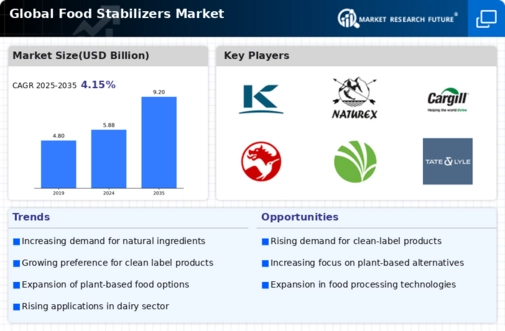Top Industry Leaders in the Food Stabilizers Market

Strategies Adopted by Food Stabilizers Key Players
The global food stabilizers market is a dynamic and evolving industry, playing a crucial role in food processing and manufacturing. Food stabilizers are substances or chemicals that allow food ingredients to maintain their texture and structure. The demand for these products is driven by the growing processed food industry, rising consumer awareness about food quality and safety, and the constant innovation in food technology.
List of Key Players
- Ingredion Incorporated (US)
- Tate & Lyle (UK)
- Nexira (France)
- DowDuPont (US)
- Cargill, Incorporated (US)
- Kerry Group Plc. (Ireland)
- Ashland (US)
- CP Kelco (US)
- Archer Daniels Midland Company (US)
- BASF SE (Germany)
- Hydrosol (Germany)
- Palsgaard (Denmark)
These companies have established their presence globally and offer a wide range of products catering to different food applications.
The market players employ various strategies to maintain and enhance their market position. These include product innovation, mergers and acquisitions, partnerships, and expansion into new markets. For instance, companies like Cargill and ADM have been actively investing in research and development to introduce new and improved products that meet changing consumer preferences and regulatory standards.
Market Share Analysis
Several factors determine the market share of companies in the food stabilizers industry. These include product portfolio diversity, global presence, brand reputation, R&D capabilities, and supply chain efficiency. MoreoverThe ability to cater to changing consumer preferences, such as the demand for natural and organic products, significantly impacts a company's market position.
New and Emerging Companies
The food stabilizers market is witnessing the entry of new and emerging companies, often focused on niche segments or innovative technologies. These companies are challenging the established players with novel solutions, often catering to specific needs like clean-label ingredients or plant-based stabilizers. The rise of startups in this sector reflects the market's potential for innovation and customization.
Industry News and Current Company Developments
In recent times, industry news has been dominated by topics like sustainability, clean label ingredients, and plant-based alternatives. Companies are increasingly publicizing their efforts in these areas, showcasing their commitment to environmental and health trends. For instance, there have been announcements about investments in plant-based stabilizer production or the development of stabilizers that meet clean-label criteria.
Investment Trends
The investment trends in the food stabilizers market reflect a focus on sustainability, health, and technology. Venture capital firms and industry players are investing in startups and technologies that promise to revolutionize the market, such as AI-driven food formulation and stabilizers derived from new, sustainable sources. There's also a noticeable increase in investment in regions like Asia-Pacific, where the food industry is rapidly growing.
Competitive Scenario
The overall competitive scenario in the food stabilizers market is marked by intense competition among key players, continuous innovation, and a focus on expanding global reach. Companies are not only competing based on product quality and price but also on their ability to meet the latest industry trends and consumer demands. This competition is fostering a rapid pace of technological advancements and product development in the sector.
Recent Developments
The food stabilizers market witnessed several significant developments. There was an increased emphasis on natural and clean-label ingredients, responding to consumer demands for healthier and more transparent food products. Innovations in this area included the development of new stabilizers derived from natural sources that do not compromise on functionality.
Additionally, sustainability became a critical focus, with companies actively exploring ways to reduce their environmental impact. This shift resulted in the adoption of more sustainable manufacturing processes and the exploration of eco-friendly raw materials for stabilizer production.
Another notable trend was the integration of digital technologies in the manufacturing and formulation of food stabilizers. AI and machine learning are being increasingly used for product development and to improve efficiency in production processes. This integration is not only optimizing operations but also enabling the customization of stabilizers for specific applications.
In terms of market expansion, there was a noticeable increase in activities in emerging markets, particularly in Asia-Pacific and Latin America. Companies expanded their operations in these regions to tap into the growing demand for processed foods and to leverage the emerging opportunities in these markets.
Mergers and acquisitions continued to be a key strategy for growth and diversification. Several significant deals were closed , with larger companies acquiring smaller players to broaden their product portfolios and strengthen their market positions. These acquisitions often aimed at acquiring novel technologies or expanding into new geographical markets.
OverallThe food stabilizers market was characterized by a blend of technological innovation, strategic market expansion, and a heightened focus on sustainability and consumer preferences. These dynamics are shaping the market's future, promising further advancements and competitive shifts in the years to come.


